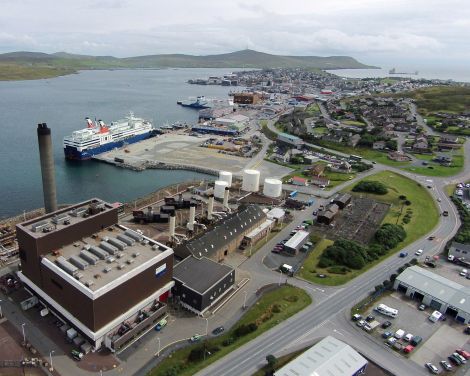News / Subsea cable set to replace power station
SHETLAND is set to be connected to the national grid for the first time – but it will not come as part of the development of large wind farm projects in the isles.
Scottish and Southern Electricity Networks (SSEN) has confirmed that a 60MW subsea cable is likely to be laid between Caithness and Shetland to replace Lerwick power station by 2021.
A joint venture between National Grid Interconnector Holdings and Aggreko has now been named as preferred bidder to provide “a new energy solution for Shetland”.
The decision has already drawn the wrath of local MSP Tavish Scott who described it as a “disastrous policy” that would lead to 25 jobs being lost at the power station, while MP Alistair Carmichael says the local community must be engaged in the process.
Shetland Islands Council political leader Cecil Smith also expressed his concern at the potential job losses.
Responding to the concern, a SSEN spokesman said: “Lerwick power station will remain operational until the new energy solution is established, expected during 2021, and during this period we are fully committed to maintain open, transparent and regular engagement with all affected employees and Trade Union representatives to discuss the options available when the station ceases to operate.
“This includes redeployment opportunities across other Scottish and Southern Electricity Networks operations in Shetland.”
If approved, National Grid would also require operational teams in Shetland at the convertor station and to maintain the back-up generation at Gremista.
The proposed 260-kilometre link will run from Dounreay to Scalloway, and then continue underground to Lerwick.
SSEN has made a formal recommendation for approval to energy regulator Ofgem. The next step in the process is a local consultation this summer to allow local people to comment on the plan.
If regulatory approval is granted, Shetland’s future energy demand will largely be met from green energy generated in the north of Scotland, thus significantly reducing the isles’ carbon footprint.
Become a member of Shetland News
Contracts to lay the subsea cable could be signed before the end of the year. Following a three-year construction period, the cable is expected to be operational by the end of 2020, by which time the ageing power station in Lerwick will close.
The cable is in no way connected to the ongoing discussions and consultations on commissioning a 600MW interconnector to export renewable energy from Shetland to the national grid.
Bids to find the most cost-effective power supply solution for the isles were sought in spring last year after energy regulator Ofgem rejected plans to build a new £200 million power station in Lerwick, in April 2014.
SSEN’s director of customer operations, Dale Cargill, said an “important milestone” in securing the future of Shetland’s electricity supply had been reached.
“Working closely with the energy regulator Ofgem, our priority throughout the tender process has been to find the optimum solution in terms of economics, efficiency and reliability to meet Shetland’s long-term electricity needs,” he said.
But Tavish Scott said he was he was furious after being told by SSE on Monday that the power station would close.
“This is a disastrous policy for Shetland and we must not accept this very bad decision. Ofgem do not care about local jobs, people or an island community. Ofgem are only interested in money,” he said.
“Our future energy needs will be dependent on a seabed cable. What happens when that breaks? We will then be reliant on a diesel generator.
“So much for security of supply; this is the ultimate in decisions made by faceless bureaucrats who don’t care about the islands.”
He said he was “devastated” for the 25 hardworking men and women who work for SSE in Lerwick and across Shetland.
“Shetland should oppose this bad decision. I will work with the islands council and other organisations who want better for our islands in this. Above all I will fight for the men and women who in a few years time, will be out of a job.”
Carmichael, meanwhile, has invited Ofgem to visit Shetland to explain their plans with the local community.
“The chief executive and chairman of Ofgem should come to Shetland to explain their proposal to the local people,” he said.
“I want them to engage with the community. In particular I want to see them work closely with the local workforce and local businesses. This is a worrying time for the workforce who will be affected and they deserve the fullest attention from the regulator. It is some years since we saw anyone from Ofgem in Shetland so a visit from the chair and chief executive is overdue.
“We know that this proposal is at the consultation stage. People are rightly sceptical about what that means. I want a consultation that is meaningful and in which local voices will be heard and not ignored. We want a future solution that will be the best for the isles and not just the cheapest. The accountants and the economists should inform this decision but theirs must not be the final word.”
Councillor Smith added: “Any decision by SSE which affects Shetland’s energy network is of enormous importance; the security of supply is a vital issue for every aspect of island life. Naturally, we are also concerned at the potential for local job losses.
“The council will be seeking early and detailed discussions with SSE to understand the finer detail and reasoning for the proposal and will also be looking to talk to Ofgem as well as the Scottish and UK governments on the issue.”
A spokesman for Ofgem responded by saying: “Lerwick power station on Shetland, built in 1953, is set to close as it reaches the end of its operating life. We told SSE, which operates the network on Shetland, to tender for the most efficient solution which protects customer interests and ensures Shetland’s security of supply once the power station closes.
“SSE have recommended a subsea cable link to the GB electricity network, alongside on-island backup generation. The cable also provides export potential for renewables on Shetland.
“We will consult on the costs of the proposal and regulatory arrangements in summer 2017. Subject to our decision we expect contracts to be signed with the successful bidder later in 2017 and the solution to be in place by the end of 2020.”
“The use of renewable energy from wind farms in the north of Scotland will assist issues such as constraint management and potentially allow consented projects to realise their investment sooner by obtaining earlier grid connection dates where capacity becomes available,” the company wrote at the time in a letter to then Highlands and Islands MSP Jamie McGrigor.
Become a member of Shetland News
Shetland News is asking its readers to consider paying for membership to get additional perks:
- Removal of third-party ads;
- Bookmark posts to read later;
- Exclusive curated weekly newsletter;
- Hide membership messages;
- Comments open for discussion.
If you appreciate what we do and feel strongly about impartial local journalism, then please become a member of Shetland News by either making a single payment, or setting up a monthly, quarterly or yearly subscription.
























































